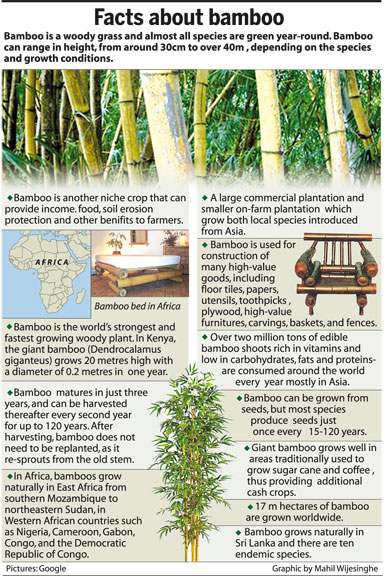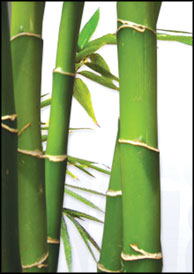|
Bamboo, the versatile raw material:
UNIDO releases $ 2.1 m to set up industries
by Surekha Galagoda
The United Nations Industrial Development Organisation (UNIDO) under
its global environment facility grant scheme has released US$ 2.1 m to
setup industries using bamboo as raw material.
 The total cost of the project is $15.9m and it will include cash and
kind, said National Director UNIDO (Sri Lanka) Nawaz Rajabdeen. The total cost of the project is $15.9m and it will include cash and
kind, said National Director UNIDO (Sri Lanka) Nawaz Rajabdeen.
He said that the objective of the project is to develop a bamboo
supply chain and product industry in Sri Lanka leading to reduced global
environmental impact from GHG emissions with a sustainable industry
base.
“The project components include policy framework, bamboo tissue
reproduction, establishment of plantations, plantation operation,
transfer of bamboo processing technology to Sri Lanka and pelletising.
UNIDO has already released the funds to start research and by the end
of this year we will commence awareness seminars to teach of the values
of bamboo, said Rajabdeen.
Residues of bamboo processing can be used for energy purposes while
bamboo sprouts (another byproduct) constitute an important food crop. At
present no significant market exists for sprouts but an ongoing project
by the international network of bamboo and rattan (INBAR)in Sri lanka is
planning to develop such an industry and markets.
The target is to develop 10,000 hectares of new bamboo plantations in
a specific region that can serve an industry cluster.
The plantations will be on degraded land.
The industry would have three products including engineered bamboo
materials for structural applications, bamboo pellets for local energy
use and for export markets and bamboo sprouts for food.
Sri lanka has no bamboo processing industry but China and India have
established industries with the support to UNIDO. This project involves
the transfer of bamboo processing technology from India and China.
Development of a bamboo industry in the country will require
technology transfer from these countries for buying of equipment,
capacity building in operating and maintaining this equipment and
development of a network of local service providers.
Technology transfer in the areas of tissue reproduction, bamboo
processing technology and bamboo pelettising technology from India and
China is planned. As a plantation takes seven years to mature it is a
project with a long life span, but after four years cropping starts and
the first products will become available which would be sufficient to
cover operation and maintenance costs.
UNIDO has helped India to rediscover bamboo.
An eco-friendly material bamboo can help the rural poor generate
income and employment opportunities - and will help the country become a
world leader in the industry.
Fourteen species of bamboo have been reported growing in Sri Lanka,
and only five of them are presently in use. They are widely used in
making crafts and scaffoldings.
Bamboo is one of the oldest materials used by people to increase
comfort and uplift human life.
It is best put to use in situations where its natural properties are
emphasised.
The strength of bamboo culms, their straightness, smoothness,
lightness, cylindric structure, abundance and shorter period in which
they attain maturity make them suitable for a wide variety of purposes.
Bamboo has excellent properties and its natural resistance to decay is
low. Chemical preservation using preservatives which have good diffusion
properties, improves the durability of bamboo structures.
World demand for handicrafts made of bamboo has increased
considerably which has helped the development of cottage industries
based on preserved bamboo. The whole biomass of the tree can be utilised.
Bamboo has several characteristics that make it a suitable and
economical building material for building construction, as well as for
scaffolding.
In place of steel, bamboo has been considered as a reinforcement
factor for concrete.
The major problem is the shortage of the raw material for utilization
in Sri Lanka. Wastage can be minimized by introducing preservation
methods.
People must be made aware of the value of bamboo to encourage their
supportive participation in development, conservation and usage aspects.
 Bamboo products can be promoted as a substitute to plastic and
polythene goods by highlighting their environment friendly qualities. Bamboo products can be promoted as a substitute to plastic and
polythene goods by highlighting their environment friendly qualities.
Bamboo resources in Sri Lanka are not as abundant as in many South
Asian countries, and consequently the importance of bamboo in the
household economy, construction, and in cottage industry is
comparatively less.
The availability of indigenous bamboo species in forest areas, such
as Ochlandra stridula, is decreasing because of deforestation and
over-exploitation.
However, they can still be found abundantly in a few areas, in
Ratnapura and Kalutara Districts.
The bigger diameter bamboos are mostly introduced species (Bambusa
vulagris and Dendracalamus giganteus), which are cultivated in
homegardens, and along roadsides and riverbanks.
The bamboo handicraft industry uses B. vulgaris and O. stridula
species and the construction industry uses B. vulagris and D. giganteus.
The bamboo industry supports about 250 families and 690 workers.
According to a survey by the Forest Department about 80 percent of
people who collect bamboo process it for household consumption. The
balance process it for domestic use or sell them to processors.
The price of bamboo has increased much faster than the rate of
inflation, which suggests that the availability of bamboo has gone down
in relation to demand.
A couple of decades ago bamboo was used mainly as material to make
poles, baskets, furniture, fences and handicraft items.
Bamboo has thousands of uses including airplane ‘skins’, desalination
filters, diesel fuel, and medicine. New bamboo shoots can be eaten. It
can also be made into fibre for clothing, used to reinforce concrete.
In Africa, bamboo is used to manufacture bicycle frames, because
bamboo absorbs shocks well and would make bike riding on a rough terrain
smoother. Bamboo makes for eco-friendly homes, which can be earthquake
resistant. Bamboo can help reduce our carbon footprint and fight global
warming. It is a crucial element in the balance of oxygen and carbon
dioxide in the atmosphere.
A grove of bamboo releases 35 percent more oxygen than an equivalent
stand of trees and absorbs four times as much carbon.
Bamboo is harvested and replenished with no impact to the
environment.
As a fast growing plant, bamboo could provide the answer to
deforestation.
A bamboo sapling grows to its full potential in four years compared
to oak that takes 50 years and others that take up to 70 years to reach
maturity.
Yet bamboo is said to be as longlasting and sturdy as oak. Bamboo is
also durable, light, and affordable,
India has 30 per cent of the world’s bamboo resources, but
contributes only four percent share of the global market. This is mainly
because of low productivity.
|

